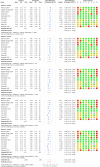Visual and patient-reported outcomes of an enhanced versus monofocal intraocular lenses in cataract surgery: a systematic review and meta-analysis
- PMID: 39893265
- PMCID: PMC11933469
- DOI: 10.1038/s41433-025-03625-4
Visual and patient-reported outcomes of an enhanced versus monofocal intraocular lenses in cataract surgery: a systematic review and meta-analysis
Abstract
Understanding the functional outcomes achieved with new enhanced monofocal intraocular lenses (IOLs) is crucial for adequately managing patient expectations. This study evaluated visual and patient-reported outcomes of an enhanced range of field IOL versus other monofocal IOLs in cataract patients. A systematic review and meta-analysis, pre-registered on PROSPERO (CRD42024561611), included studies from Medline (PubMed), Embase (Ovid), and trial registries (2019-2024) focused on binocular cataract surgeries with various IOL models. Primary outcomes assessed were monocular distance-corrected visual acuities (CDVA, DCIVA, DCNVA), defocus curves, and contrast sensitivity; secondary measures included binocular visual acuities and patient-reported outcomes such as spectacle independence and photic phenomena. Out of 31 studies (8 randomized clinical trials, 23 case series), high-certainty evidence indicated no significant difference in CDVA between enhanced and conventional IOLs. However, enhanced IOLs demonstrated better intermediate (DCIVA: -0.11 logMAR, CI 95%: -0.13 to -0.10) and near (DCNVA: -0.12 logMAR, CI 95%: -0.17 to -0.07) visual acuities, supported by defocus curves, though with lower-certainty evidence. No significant differences were observed in contrast sensitivity or photic phenomena, and evidence for positive dysphotopsia was moderate to low. Enhanced IOLs significantly favored intermediate-distance spectacle independence, with an odds ratio of 7.85 (CI 95%: 4.08-15.09), though no differences were observed for distance spectacle independence. Near-distance spectacle independence also favored enhanced IOLs, though with low-certainty evidence. In summary, enhanced IOLs provide improved intermediate and near visual acuities compared to conventional monofocal IOLs, though further studies are needed to confirm outcomes in contrast sensitivity and patient-reported outcomes across various enhanced monofocal IOLs.
© 2025. The Author(s).
Conflict of interest statement
Competing interests: JF is a shareholder of Qvision (Indaloftal SL); consultant for Medicontur; grants from Carl Zeiss and Johnson & Johnson; speakers’ bureaus of Carl Zeiss Meditec, Inc.; Oculus, LLC; Staar Surgical; and Bausch + Lomb, Inc; expenses for congresses have been covered by SIFI and Thea. The remaining authors have nothing to disclose.
Figures








Similar articles
-
A comparative study and review of visual outcomes with enhanced versus standard monofocal intraocular lenses following cataract surgery.Med Hypothesis Discov Innov Ophthalmol. 2025 Jul 31;14(2):28-39. doi: 10.51329/mehdiophthal1521. eCollection 2025 Summer. Med Hypothesis Discov Innov Ophthalmol. 2025. PMID: 40787279 Free PMC article.
-
Accommodative intraocular lens versus standard monofocal intraocular lens implantation in cataract surgery.Cochrane Database Syst Rev. 2014 May 1;2014(5):CD009667. doi: 10.1002/14651858.CD009667.pub2. Cochrane Database Syst Rev. 2014. PMID: 24788900 Free PMC article.
-
Multifocal versus monofocal intraocular lenses after cataract extraction.Cochrane Database Syst Rev. 2016 Dec 12;12(12):CD003169. doi: 10.1002/14651858.CD003169.pub4. Cochrane Database Syst Rev. 2016. PMID: 27943250 Free PMC article.
-
Trifocal versus extended depth of focus (EDOF) intraocular lenses after cataract extraction.Cochrane Database Syst Rev. 2024 Jul 10;7(7):CD014891. doi: 10.1002/14651858.CD014891.pub2. Cochrane Database Syst Rev. 2024. PMID: 38984608 Free PMC article.
-
Trifocal intraocular lenses versus bifocal intraocular lenses after cataract extraction among participants with presbyopia.Cochrane Database Syst Rev. 2023 Jan 27;1(1):CD012648. doi: 10.1002/14651858.CD012648.pub3. Cochrane Database Syst Rev. 2023. PMID: 36705482 Free PMC article.
Cited by
-
A comparative study and review of visual outcomes with enhanced versus standard monofocal intraocular lenses following cataract surgery.Med Hypothesis Discov Innov Ophthalmol. 2025 Jul 31;14(2):28-39. doi: 10.51329/mehdiophthal1521. eCollection 2025 Summer. Med Hypothesis Discov Innov Ophthalmol. 2025. PMID: 40787279 Free PMC article.
-
Effects of enhanced monofocal intraocular lenses on intermediate and near vision.Eye (Lond). 2025 Apr;39(6):1226. doi: 10.1038/s41433-025-03704-6. Epub 2025 Feb 15. Eye (Lond). 2025. PMID: 39955373 No abstract available.
-
Clinical Outcomes and Optical Bench Analysis of a Novel Enhanced Monofocal Intraocular Lens.Life (Basel). 2025 Jun 19;15(6):984. doi: 10.3390/life15060984. Life (Basel). 2025. PMID: 40566635 Free PMC article.
-
Navigating the Lens Labyrinth: A Practical Approach to Intraocular Lens Classification and Selection.Ophthalmol Ther. 2025 Sep;14(9):2313-2322. doi: 10.1007/s40123-025-01212-0. Epub 2025 Jul 24. Ophthalmol Ther. 2025. PMID: 40705184 Free PMC article.
References
-
- Eyewire. New Technology, Greater Patient Awareness Will Help Drive Gains in Premium Cataract Surgery. Source: Market Scope’s “2021 Premium Cataract Surgery Market Report”. 2021. https://eyewire.news/news/new-technology-greater-patient-awareness-will-.... Accessed Dec 14 2023.
-
- Fernández J, Ribeiro F, Rocha-de-Lossada C, Rodríguez-Vallejo M. Functional classification of intraocular lenses based on defocus curves: a scoping review and cluster analysis. J Refract Surg. 2024;40:e108–16. - PubMed
-
- Mencucci R, Cennamo M, Venturi D, Vignapiano R, Favuzza E. Visual outcome, optical quality, and patient satisfaction with a new monofocal IOL, enhanced for intermediate vision: preliminary results. J Cataract Refract Surg. 2020;46:378–87. - PubMed
-
- Wan KH, Au ACK, Kua WN, Ng ALK, Cheng GPM, Lam NM, et al. Enhanced monofocal versus conventional monofocal intraocular lens in cataract surgery: a meta-analysis. J Refract Surg. 2022;38:538–46. - PubMed
Publication types
MeSH terms
LinkOut - more resources
Full Text Sources

